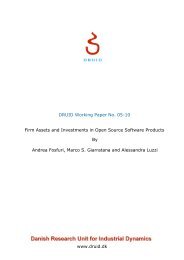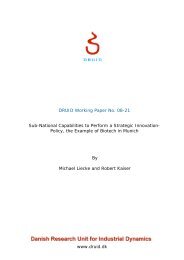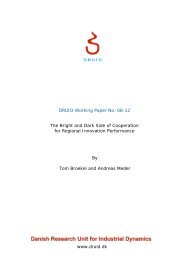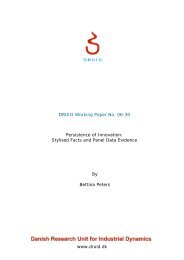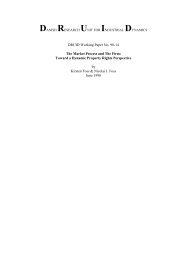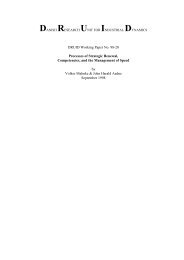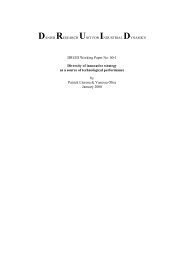danish research unit for industrial dynamics druid working paper no ...
danish research unit for industrial dynamics druid working paper no ...
danish research unit for industrial dynamics druid working paper no ...
Create successful ePaper yourself
Turn your PDF publications into a flip-book with our unique Google optimized e-Paper software.
234. Production of specific assets and their transferIn order to occur, learning needs some specific commitments both in tangible andintangible assets <strong>for</strong> sustaining cooperation (Lazaric and Wolff, 1996; Gulati et al., 1994).These resources play two roles: on the one hand they coordinate diversity of k<strong>no</strong>wledgecoming from the association of two different corporate cultures and on the other hand theypreserve cooperation by creating irreversibility’s. If the partners do <strong>no</strong>t commit someresources, cooperation has little chance of succeeding. Firms engaging in cooperation haveto make a bet on the future rents from the alliance and must commit some resources withouthaving any degree of certainty about the returns on this kind of cooperation. In fact thisprocess is <strong>no</strong>t an automatic one and needs time <strong>for</strong> creating a climate of trust and <strong>for</strong>finding some organisational rules able to coordinate the diversity without bringing intoquestion the identities of the two firms involved (Bureth et al., 1996).Specific tech<strong>no</strong>logical assets can be embodied in some specific equipment but can alsoinclude some collective competencies, as we usually find in the design phase. They can berelational through the creation of many ties during the project or be<strong>for</strong>e its implementation.These assets are very important <strong>for</strong> mobilising new combinations of k<strong>no</strong>wledge whichcan<strong>no</strong>t be created if conflicts between firms exist. In this way, these relational assets aresustained by personal trust coming from close interactions between individuals <strong>working</strong>together. Finally as we shall show later, relational assets are the first step <strong>for</strong> improvingcoordination by helping the creation of some appropriate organisational mechanisms suchas rules or routines 5 . From a<strong>no</strong>ther side specific assets either tech<strong>no</strong>logical, relational ororganisational produce some strong externalities and increase returns to the ongoinglearning (Levinthal and March, 1981; March, 1991).These externalities promote exchange of in<strong>for</strong>mation and k<strong>no</strong>wledge that create a degree oflock-in which discourages the cooperation with others partners. That is the reason why welook very carefully at the nature of assets produced because some part of them may belocked in and difficult to transfer while some others may be re-deployed in different5 We would like to stress that building competencies in agreements can<strong>no</strong>t overlook the role of humancapital which play an active part in the trans<strong>for</strong>mation and adaptation of the tech<strong>no</strong>logy. These relationaland organizational resources are important <strong>for</strong> increasing the problem-solving capacity of each firm andmay be considered as assets (Winter, 1987).



